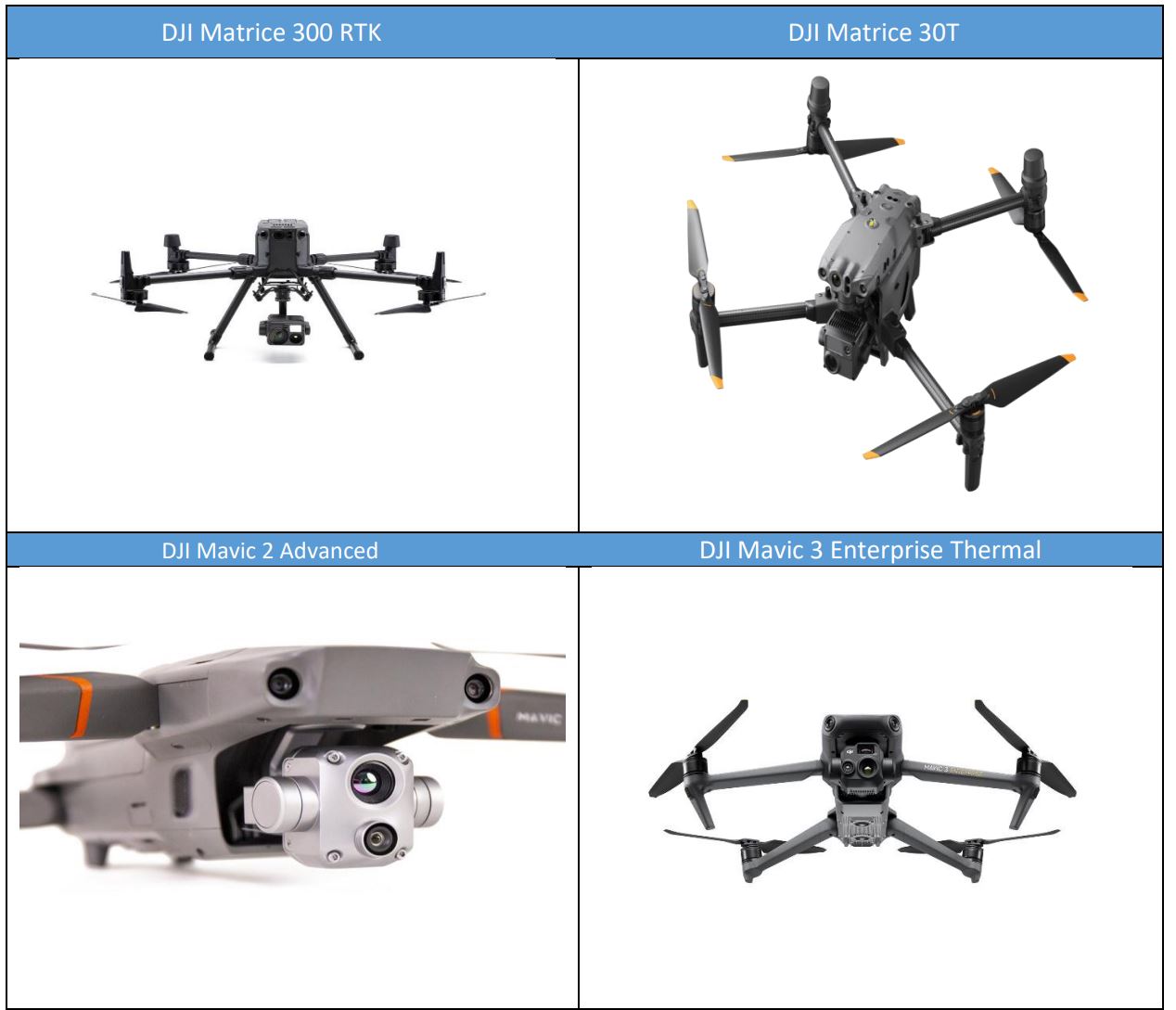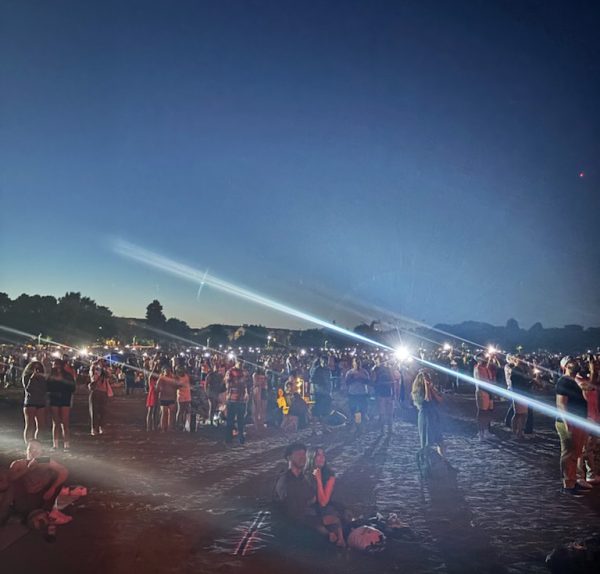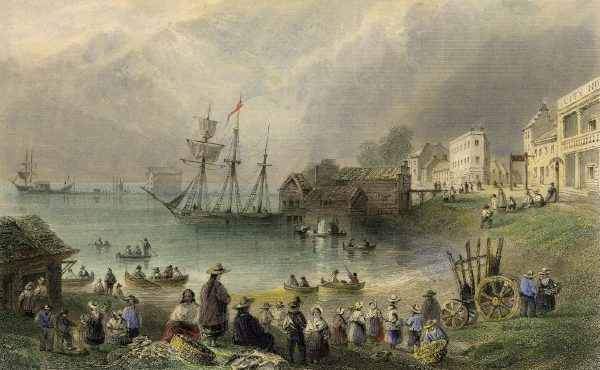On the evening of July 1, after the sky darkened and the fireworks over Ashbridge’s Bay began, some participants noticed eight police drones monitoring the crowds, occasionally sweeping their lights down on specific locations to indicate some activity for the accompanying officers to investigate.
“Six of them had a red light and two of them had a green light,” according to one observer who had also seen them on Victoria Day. “The red-light ones were equipped with this intense spotlight capability. [On the] Victoria Day weekend, when someone in the crowd set off their own private firework, the drone would rush over, shine the light on the spot, then officers would rush over in their small ATV-type vehicles with their sirens on while the spotlight was maintained on the spot! It really was dystopian.”
These drones — or, as the Toronto Police Service dubs them, “Remotely Piloted Aircraft Systems” (RPAS) — are part of a fleet of 21 units which “support the full spectrum of police operations,” according to an FAQ provided to Spacing.
The list of uses includes search and rescue, tactical response, hazardous material incidents, disaster incidents, public safety at large gatherings and special events, aerial documentation of collisions and crime scenes, subject apprehensions including Canine Unit operations, fire scenes, and site safety surveys.
The TPS first acquired a handful of drones in 2016 — the second year of John Tory’s mayoralty — and initially used them mainly to map traffic accident scenes and conduct search and rescue operations. The fleet’s size has grown steadily in the years since then. In 2022, according to a drone industry magazine, the TPS had 16 RPAS and 25 trained pilots. The fleet size has expanded 37% in just two years.

So, evidently, have the applications, raising tough but important questions about mission creep and public accountability involving a powerfully intrusive technology that’s attracted regulatory scrutiny in many jurisdictions. These include issues such as the combination of drone video capabilities and AI-based facial recognition software, the retention of video footage captured by the drones, the potential deployment of these devices during political protests, and the collection of surveillance video when the drone is not within the sight-lines of the operator.
Besides provincial privacy laws and federal navigation regulations, there are no policy constraints on how the TPS may use its fleet, nor much in the way of a regulated paper trail about what happens to the video/surveillance data captured by these devices (more on this point in a moment).
The civilian oversight body, the Toronto Police Services Board, has never held public consultations or adopted any kind of policy framework governing drone use, and this despite the steady expansion of the program over a period of eight years. “After reviewing our policy library and available documentation, I can confirm that the Board does not currently have a policy on the use of drones/RPAS nor is there a record of such a policy being discussed by the Board,” Anne Arthur, the TPSB’s senior advisor, strategic analysis and governance, told Spacing.
The policy vacuum is surprising, given that Ontario’s former Information and Privacy Commissioner, Ann Cavoukian, publicly upbraided the Hamilton Police Service for its failure to properly manage its drone fleet. “What Hamilton police is doing with these drones is appalling,” Ann Cavoukian told CBC Hamilton in May, 2023. “I don’t believe the value of it is greater than the harm it introduces.” The Canadian Civil Liberties Association called on HPS to halt the expansion of its drone program altogether, citing uses identical to the ones cited by the TPS.
The CBC also discovered that HPS never consulted the Information and Privacy Commission of Ontario (IPCO) about its drone program. (The IPCO earlier this year issued a “guidance” document to Ontario police services about the appropriate use of facial recognition software on mugshot databases and a range of concerns associated with such practices.)
Toronto and Ontario’s seeming indifference to the regulation of the use of police drones stands in sharp contrast to the approaches of other jurisdictions, including the U.S. and the U.K. In the U.S., there are now an estimated 1,500 agencies, the majority of them involved in federal, state or municipal law enforcement, that use drones. Eighteen states have passed legislation requiring agencies to obtain search warrants prior to using drones for surveillance, according to an overview of regulation published by Airsight, a drone security technology firm.
An important driver of the regulatory activity is the fast-growing adaption of drones by law enforcement agencies. Police1, a law enforcement news site, estimates that the number of American agencies using drones has risen 54% in the past six years alone.
One particular trend that has provoked concern among civil liberties groups is the use of drones as first responders to 911 calls. While such applications potentially provide first responders with better “situational awareness,” the practical result, according to a June, 2024, brief by the Electronic Frontier Foundation, is that “law enforcement’s desire to get `a view of the scene’ becomes a justification for over-surveilling neighborhoods that produce more 911 calls and for collecting information on anyone who happens to be in the drone’s path.”
The U.K. has seen similar rising rates of adoption, prompting the national Biometric and Surveillance Camera Commissioner last year to issue a series of recommendations about improved controls based on a survey of law enforcement agencies showing “patchy” practices around issues such as the security of data gathered by the drones, lack of external scrutiny of ethical use of drones by police, and the need for “consistent guidance.”
“Drones represent one of the biggest future flashpoints around new policing technologies,” says Andrew Guthrie Ferguson, a law professor at American University Washington College of Law and the author of The Rise of Big Data Policing (2017). “The privacy dangers are much greater than other technologies and yet there has been little public uproar.”
Data retention, he points out, is an especially murky piece of this story.
According to TPS, video gathered by its drones is uploaded to a site called Evidence.com, which provides secure private cloud storage. “RPAS photos and videos are saved for a period of seven days unless they are categorized as evidence in an actual crime or formal investigation. In such cases, they are stored for a period of time consistent with all other evidence related to that specific incident or investigation.”
Evidence.com belongs to a US$1.9 billion/year Arizona-based security technology giant called Axon, which describes itself as “a force multiplier for your agency.” The company offers a range of highly integrated products and services — everything from tasers and body-worn cameras to a wide array of software, among them for evidence retention.
Ferguson observes that Axon, through Evidence.com, seems to want to corner the market on data storage — not just drone footage, but also video from body-worn cameras — vast amounts of data, necessitating substantial computing capacity. “Our growing reliance on video footage is changing the balance of power between public officials and private vendors,” he says. “Public images taken by public servants for public safety purposes are now dependent on a private cloud provider that must answer to its profit-minded shareholders.”
It’s also worth noting that all of the TPS drone footage gathered at events such as those July 1 fireworks displays ends up in a cloud run by an American company, presumably in a server farm outside Canada’s borders.
There are no extant rules about the storage of such data outside Canada, according to University of Ottawa law professor Teresa Scassa, Canada Research Chair in Information Law and Policy and an expert on smart city technology.
“There is no localization requirement for the broader public service in Ontario, although the police would have to take reasonable steps to ensure that the data are properly secure and are not being used for unauthorized secondary purposes,” she says, adding that the only way for the public to be independently assured that such precautionary steps have, indeed, been taken would be through an assessment by the provincial privacy commissioner.
A generation ago, the TPS and then-mayor Mel Lastman became embroiled in a media controversy about the use of police helicopters, including donated ones. That fight, today, seems positively quaint, even though it generated far more sound and fury by comparison to what little has passed for a proper policy scrutiny about the TPS’s current and future use of drones.
Not surprisingly, such a debate did not happen when Tory was mayor and the TPSB was stacked with cronies. But the political wheel has turned, so one could reasonably ask whether the councillors now on the board — Lily Cheng, Amber Morley, and Shelley Carroll, as well as council appointee Nadine Spencer — are prepared to initiate a detailed discussion about drone accountability.
Given that we’ve reached the point when the TPS evinces no qualms about dispatching its RPAS fleet to Canada Day festivities to keep an eye on a celebratory crowd, that debate seems long overdue.




One comment
Technology products and services used by law enforcement agencies have very little oversight. The procurement processes for law enforcement technology is often a black box process itself. The decision to purchase a particular product or service is often buried under larger budget items, and often only known at a late stage after the purchase has been completed, rather than at an earlier stage of procurement where preventive action can be taken for potentially problematic technologies.